ABS MITSUBISHI L200 2015 Owner's Manual (in English)
[x] Cancel search | Manufacturer: MITSUBISHI, Model Year: 2015, Model line: L200, Model: MITSUBISHI L200 2015Pages: 418, PDF Size: 25.8 MB
Page 2 of 418
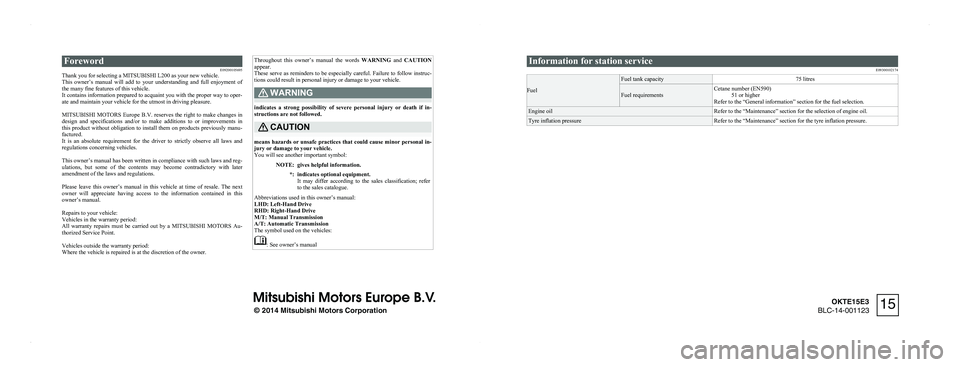
ForewordE09200105695
Thank you for selecting a MITSUBISHI L200 as your new vehicle.
This owner’s manual will add to your understanding and full enjoyment of
the many fine features of this vehicle.
It contains information prepared to acquaint you with the proper way to oper-
ate and maintain your vehicle for the utmost in driving pleasure.
MITSUBISHI MOTORS Europe B.V. reserves the right to make changes in
design and specifications and/or to make additions to or improvements in
this product without obligation to install them on products previously manu- factured.
It is an absolute requirement for the driver to strictly observe all laws and
regulations concerning vehicles.
This owner’s manual has been written in compliance with such laws and reg- ulations, but some of the contents may become contradictory with later amendment of the laws and regulations.
Please leave this owner’s manual in this vehicle at time of resale. The next
owner will appreciate having access to the information contained in this
owner’s manual.
Repairs to your vehicle:
Vehicles in the warranty period:
All warranty repairs must be carried out by a MITSUBISHI MOTORS Au-
thorized Service Point.
Vehicles outside the warranty period:
Where the vehicle is repaired is at the discretion of the owner.
Throughout this owner’s manual the words WARNING and CAUTION
appear.
These serve as reminders to be especially careful. Failure to follow instruc-
tions could result in personal injury or damage to your vehicle.WARNING
indicates a strong possibility of severe personal injury or death if in- structions are not followed.
CAUTION
means hazards or unsafe practices that could cause minor personal in-
jury or damage to your vehicle.
You will see another important symbol:
NOTE:gives helpful information.*:indicates optional equipment.
It may differ according to the sales classification; refer to the sales catalogue.
Abbreviations used in this owner’s manual:
LHD: Left-Hand Drive
RHD: Right-Hand Drive
M/T: Manual Transmission
A/T: Automatic Transmission
The symbol used on the vehicles:
: See owner’s manual
Information for station service
E09300102174
Fuel
Fuel tank capacity75 litresFuel requirementsCetane number (EN590)51 or higher
Refer to the “General information” section for the fuel selection.Engine oilRefer to the “Maintenance” section for the selection of engine oil.Tyre inflation pressureRefer to the “Maintenance” section for the tyre inflation pressure.
© 2014 Mitsubishi Motors Corporation
15
OKTE15E3
BLC-14-001123
Page 59 of 418
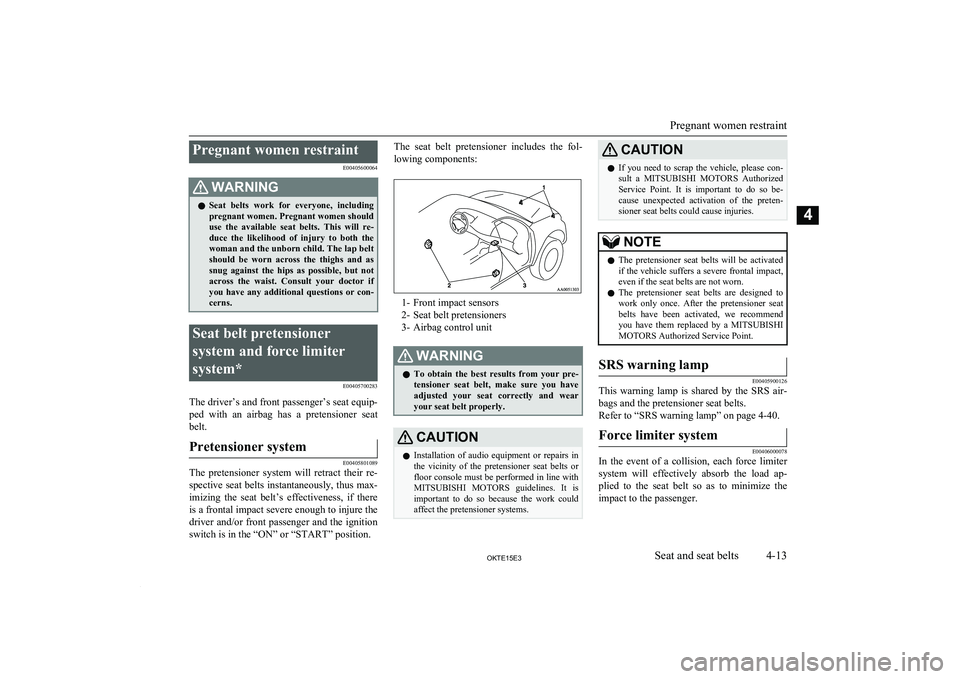
Pregnant women restraintE00405600064WARNINGlSeat belts work for everyone, including
pregnant women. Pregnant women should
use the available seat belts. This will re- duce the likelihood of injury to both thewoman and the unborn child. The lap belt
should be worn across the thighs and as snug against the hips as possible, but not
across the waist. Consult your doctor if you have any additional questions or con-
cerns.Seat belt pretensioner
system and force limiter
system* E00405700283
The driver’s and front passenger’s seat equip-ped with an airbag has a pretensioner seat belt.
Pretensioner system
E00405801089
The pretensioner system will retract their re-
spective seat belts instantaneously, thus max-imizing the seat belt’s effectiveness, if there
is a frontal impact severe enough to injure the
driver and/or front passenger and the ignition
switch is in the “ON” or “START” position.
The seat belt pretensioner includes the fol-
lowing components:
1- Front impact sensors
2- Seat belt pretensioners
3- Airbag control unit
WARNINGl To obtain the best results from your pre-
tensioner seat belt, make sure you have
adjusted your seat correctly and wear your seat belt properly.CAUTIONl Installation of audio equipment or repairs in
the vicinity of the pretensioner seat belts or
floor console must be performed in line with MITSUBISHI MOTORS guidelines. It is
important to do so because the work could affect the pretensioner systems.CAUTIONl If you need to scrap the vehicle, please con-
sult a MITSUBISHI MOTORS Authorized
Service Point. It is important to do so be- cause unexpected activation of the preten-
sioner seat belts could cause injuries.NOTEl The pretensioner seat belts will be activated
if the vehicle suffers a severe frontal impact, even if the seat belts are not worn.
l The pretensioner seat belts are designed to
work only once. After the pretensioner seat
belts have been activated, we recommend you have them replaced by a MITSUBISHI
MOTORS Authorized Service Point.SRS warning lamp
E00405900126
This warning lamp is shared by the SRS air-
bags and the pretensioner seat belts.
Refer to “SRS warning lamp” on page 4-40.
Force limiter system
E00406000078
In the event of a collision, each force limiter system will effectively absorb the load ap- plied to the seat belt so as to minimize the
impact to the passenger.
Pregnant women restraint
4-13OKTE15E3Seat and seat belts4
Page 80 of 418
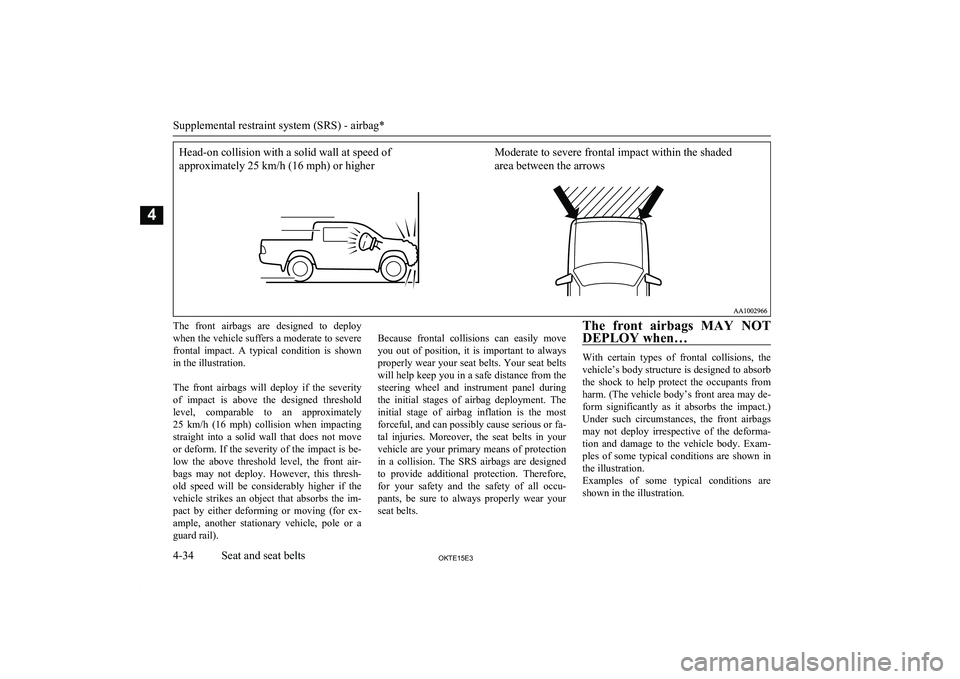
Head-on collision with a solid wall at speed of
approximately 25 km/h (16 mph) or higher Moderate to severe frontal impact within the shaded
area between the arrowsThe front airbags are designed to deploy
when the vehicle suffers a moderate to severe frontal impact. A typical condition is shown
in the illustration.
The front airbags will deploy if the severity of impact is above the designed threshold level, comparable to an approximately
25 km/h (16 mph) collision when impacting
straight into a solid wall that does not move or deform. If the severity of the impact is be-low the above threshold level, the front air- bags may not deploy. However, this thresh-
old speed will be considerably higher if the
vehicle strikes an object that absorbs the im- pact by either deforming or moving (for ex-
ample, another stationary vehicle, pole or a
guard rail).
Because frontal collisions can easily move you out of position, it is important to always
properly wear your seat belts. Your seat belts will help keep you in a safe distance from thesteering wheel and instrument panel during
the initial stages of airbag deployment. The
initial stage of airbag inflation is the most
forceful, and can possibly cause serious or fa- tal injuries. Moreover, the seat belts in your
vehicle are your primary means of protection in a collision. The SRS airbags are designed
to provide additional protection. Therefore,
for your safety and the safety of all occu-
pants, be sure to always properly wear your seat belts.The front airbags MAY NOT
DEPLOY when…
With certain types of frontal collisions, the vehicle’s body structure is designed to absorbthe shock to help protect the occupants fromharm. (The vehicle body’s front area may de-form significantly as it absorbs the impact.) Under such circumstances, the front airbags
may not deploy irrespective of the deforma- tion and damage to the vehicle body. Exam-
ples of some typical conditions are shown in
the illustration.
Examples of some typical conditions are shown in the illustration.
Supplemental restraint system (SRS) - airbag*
4-34OKTE15E3Seat and seat belts4
Page 84 of 418
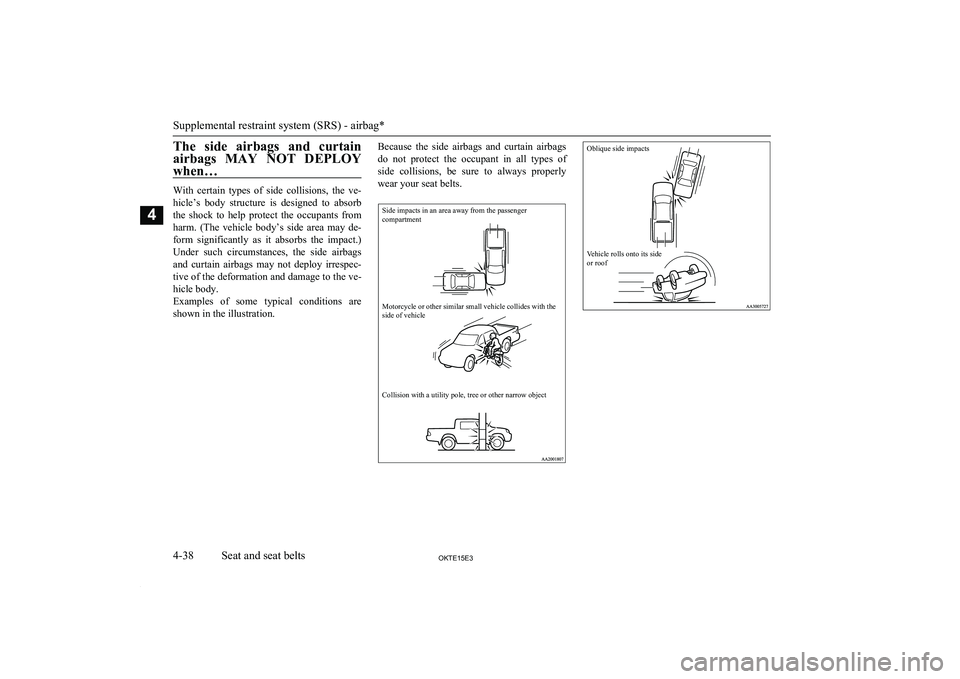
The side airbags and curtainairbags MAY NOT DEPLOY
when…
With certain types of side collisions, the ve-
hicle’s body structure is designed to absorb
the shock to help protect the occupants fromharm. (The vehicle body’s side area may de-form significantly as it absorbs the impact.) Under such circumstances, the side airbags and curtain airbags may not deploy irrespec-tive of the deformation and damage to the ve-
hicle body.
Examples of some typical conditions are shown in the illustration.
Because the side airbags and curtain airbags
do not protect the occupant in all types of
side collisions, be sure to always properly wear your seat belts.Side impacts in an area away from the passenger
compartmentMotorcycle or other similar small vehicle collides with the
side of vehicleCollision with a utility pole, tree or other narrow objectOblique side impactsVehicle rolls onto its side
or roof
Supplemental restraint system (SRS) - airbag*
4-38OKTE15E3Seat and seat belts4
Page 94 of 418
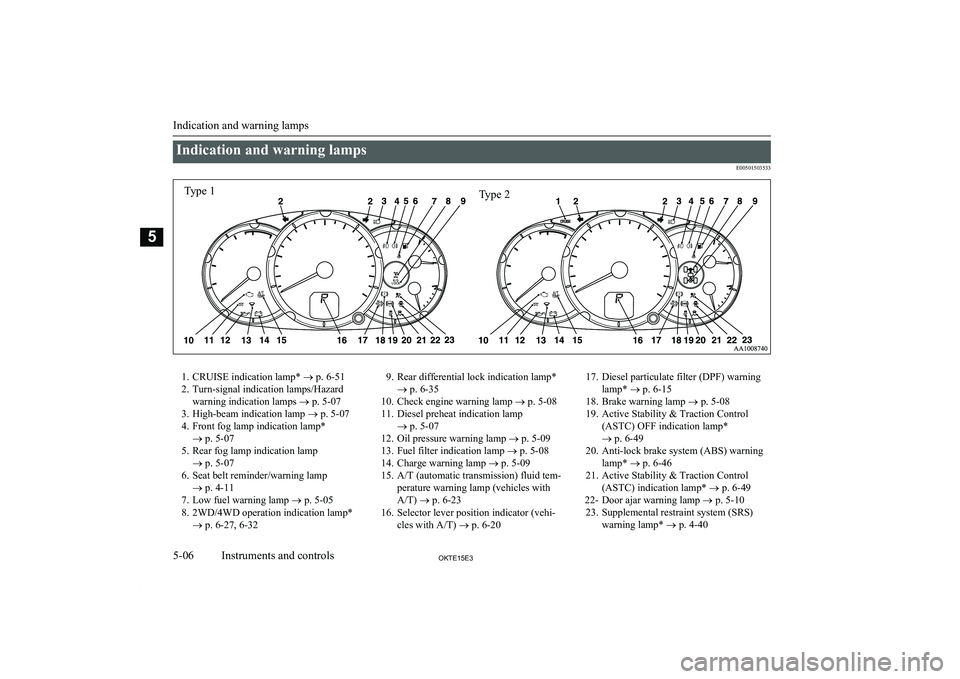
Indication and warning lampsE005015035331. CRUISE indication lamp* ® p. 6-51
2. Turn-signal indication lamps/Hazard warning indication lamps ® p. 5-07
3. High-beam indication lamp ® p. 5-07
4. Front fog lamp indication lamp* ® p. 5-07
5. Rear fog lamp indication lamp ® p. 5-07
6. Seat belt reminder/warning lamp ® p. 4-11
7. Low fuel warning lamp ® p. 5-05
8. 2WD/4WD operation indication lamp* ® p. 6-27, 6-329. Rear differential lock indication lamp*
® p. 6-35
10. Check engine warning lamp ® p. 5-08
11. Diesel preheat indication lamp ® p. 5-07
12. Oil pressure warning lamp ® p. 5-09
13. Fuel filter indication lamp ® p. 5-08
14. Charge warning lamp ® p. 5-09
15. A/T (automatic transmission) fluid tem- perature warning lamp (vehicles with
A/T) ® p. 6-23
16. Selector lever position indicator (vehi- cles with A/T) ® p. 6-2017. Diesel particulate filter (DPF) warning
lamp* ® p. 6-15
18. Brake warning lamp ® p. 5-08
19. Active Stability & Traction Control (ASTC) OFF indication lamp*
® p. 6-49
20. Anti-lock brake system (ABS) warning lamp* ® p. 6-46
21. Active Stability & Traction Control (ASTC) indication lamp* ® p. 6-49
22- Door ajar warning lamp ® p. 5-10
23. Supplemental restraint system (SRS) warning lamp* ® p. 4-40
Indication and warning lamps
5-06OKTE15E3Instruments and controls5Type 1Type 2
Page 96 of 418

Fuel filter indication lamp
E00509900170
This indication lamp illumi-
nates when the ignition switch is turned to the “ON”
position and goes off after the engine has started. If itlights up while the engine is
running, it indicates that water has accumula- ted inside the fuel filter; if this happens, re-
move the water from the fuel filter.
Refer to “Removal of water from the fuel fil- ter” on page 8-06.When the lamp goes out, you can resume
driving. If it either does not go out or comes on from time to time, we recommend you to
have the vehicle inspected.Warning lamps
E00502400017Brake warning lamp
E00502501637
This lamp illuminates whenthe ignition switch is turnedto the “ON” position, and goes off after a few seconds.
Always make sure that the
lamp goes off before driving.
With the ignition switch in the “ON” posi-
tion, the brake warning lamp illuminates un- der the following conditions:
l When the parking brake lever has been
engaged.
l When the brake fluid level in the reser-
voir falls to a low level.
l When the brake force distribution func-
tion is not operating correctly. (vehicles
with anti-lock brake system)CAUTIONl In the situations listed below, brake perform-
ance may be compromised or the vehicle
may become unstable if brakes are applied
suddenly; consequently, avoid driving at high speeds or applying the brakes suddenly.
Furthermore, immediately the vehicle should be brought to a stop in a safe location and to have it checked.
• The brake warning lamp does not illumi-
nate when the parking brake is applied ordoes not turn off when the parking brake is released.
• The ABS warning lamp and brake warn-
ing lamp illuminate at the same time.
For details, refer to “ABS warning lamp”
on page 6-46. (vehicles with anti-lock
brake system)
• The brake warning lamp remains illumi-
nated during driving.
l The vehicle should be brought to a halt in
the following manner when brake perform-
ance has deteriorated.
• Depress the brake pedal harder than usual.
Even if the brake pedal moves down to
the very end of its possible stroke, keep it
pressed down hard.CAUTION• Should the brakes fail, use engine braking
to reduce your speed and carefully pull the parking brake lever to park your vehi-
cle.
Depress the brake pedal to operate the
stop lamp to alert the vehicles behind you.Check engine warning lamp
E00502601944
This lamp is a part of an on-
board diagnostic system
which monitors the emis-
sions, engine and automatic transmission control sys-tems.
If a problem is detected in one of these sys- tems, this lamp illuminates.
Although your vehicle will usually be driva-
ble and not need towing, we recommend you
to have the system checked as soon as possi-
ble.
[Vehicles to comply with the Euro 3 and Eu-
ro 4 regulation]
This lamp will also illuminate for a few sec- onds when the ignition switch is turned to the “ON” position. If it does not go off after a
few seconds, we recommend you to have the vehicle checked.
[Vehicles to comply with the Euro 5+]
Warning lamps
5-08OKTE15E3Instruments and controls5
Page 133 of 418

Economical driving............................................................................. 6-02
Driving, alcohol and drugs.................................................................. 6-02
Safe driving techniques....................................................................... 6-03
Running-in recommendations............................................................. 6-04 Parking brake...................................................................................... 6-07
Parking................................................................................................ 6-08
Steering wheel height adjustment....................................................... 6-09
Inside rear-view mirror....................................................................... 6-09 Outside rear-view mirrors................................................................... 6-10
Ignition switch.....................................................................................6-12 Steering wheel lock............................................................................. 6-13
Starting................................................................................................ 6-13 Diesel particulate filter (DPF)*........................................................... 6-15Manual transmission........................................................................... 6-16Automatic transmission Sports Mode 4A/T, 5A/T............................. 6-19Easy select 4WD*............................................................................... 6-25
Super select 4WD*..............................................................................6-29
Rear differential lock*........................................................................ 6-34 4-wheel drive operation...................................................................... 6-38
Inspection and maintenance following rough road operation............. 6-41
Cautions on handling of 4-wheel drive vehicles................................. 6-41
Limited-slip differential*.................................................................... 6-43
Braking................................................................................................ 6-43
Brake assist system*........................................................................... 6-44
Anti-lock brake system (ABS)*.......................................................... 6-45
Power steering system.........................................................................6-48 Active Stability & Traction Control (ASTC)*....................................6-48
Cruise control*.................................................................................... 6-50 Cargo loads......................................................................................... 6-55Trailer towing......................................................................................6-55Starting and driving
OKTE15E36
Page 168 of 418

The opera-
tion state of rear differ- ential lock
Rear differential lock indi- cation lampRear differ-ential lock
deactivated
Switching in progress
Rear differ-ential lock activated
: Blink
: Illuminate (steady)
: Remain off
NOTEl The indication lamp blinks while the rear
differential lock is being switched between
its activated and deactivated conditions. When the switching operation is complete,
the indication lamp is either illuminated steadily or not illuminated.
l On vehicles with the active stability & trac-
tion control (ASTC) and anti-lock brake sys-
tem (ABS), the ASTC and ABS functions are suspended while the rear differential lock
is activated. ASTC indication lamp, ASTC OFF indication lamp and ABS warning lamp
are illuminated while these functions are
suspended. It does not indicate a problem. When the rear differential lock is disengag-
ed, these lamps go out and function again.
Refer to “ABS warning lamp” on page 6-46, “ASTC indication lamp, ASTC OFF in-
dication lamp” on page 6-49.
l On vehicles with the anti-lock brake system
(ABS), the ABS function is suspended while the rear differential lock is activated.
The ABS warning lamp is illuminated while
ABS functionality is suspended.
Refer to “ABS warning lamp” on page 6-46.
l If the indication lamp continues blinking af-
ter the switch has been pressed to deactivate the rear differential lock, hold the steering
wheel in the straight ahead position then slowly depress and release the accelerator
pedal several times.
l If the indication lamp continues blinking af-
ter the switch has been pressed to activateNOTEthe rear differential lock, bear in mind the following instructions:
• If the vehicle speed is
12 km/h (7 mph) or
higher, decelerate to a speed of 6 km/h
(4 mph) or lower. The indication lamp will illuminate steadily and the rear differ-
ential lock will be activated.
• If the vehicle speed is
12 km/h (7 mph) or
lower, turn the steering wheel from side to
side until the indication lamp illuminates
steadily. If the vehicle is stuck in soft ground, make sure the area around the ve-
hicle is clear then repeatedly attempt to
drive forward and backward. The indica- tion lamp will illuminate steadily and the
rear differential lock will be activated.Examples of effective use of the
rear differential lock
E00606400058
CAUTIONl Use the rear differential lock only as an
emergency measure when the vehicle is stuck and cannot be freed with the transfer
shift lever in “4L” or “4H” position (easy se-
lect 4WD) or in “4LLc” or “4HLc” position (super select 4WD). Deactivate the rear dif-
ferential lock immediately after using it.
Rear differential lock*
6-36OKTE15E3Starting and driving6
Page 173 of 418
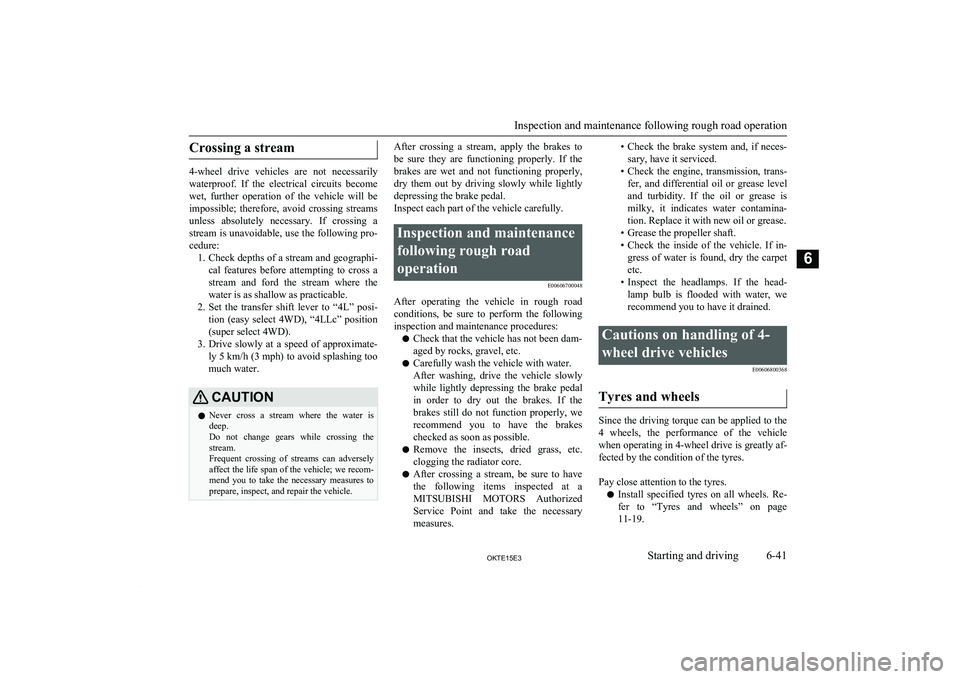
Crossing a stream
4-wheel drive vehicles are not necessarilywaterproof. If the electrical circuits become
wet, further operation of the vehicle will be impossible; therefore, avoid crossing streams
unless absolutely necessary. If crossing a stream is unavoidable, use the following pro-
cedure: 1. Check depths of a stream and geographi-
cal features before attempting to cross a stream and ford the stream where the
water is as shallow as practicable.
2. Set the transfer shift lever to “4L” posi-
tion (easy select 4WD), “4LLc” position (super select 4WD).
3. Drive slowly at a speed of approximate-
ly 5 km/h (3 mph) to avoid splashing too
much water.
CAUTIONl Never cross a stream where the water is
deep.
Do not change gears while crossing the stream.
Frequent crossing of streams can adversely
affect the life span of the vehicle; we recom- mend you to take the necessary measures toprepare, inspect, and repair the vehicle.After crossing a stream, apply the brakes to
be sure they are functioning properly. If the
brakes are wet and not functioning properly,
dry them out by driving slowly while lightly depressing the brake pedal.
Inspect each part of the vehicle carefully.Inspection and maintenance
following rough roadoperation E00606700048
After operating the vehicle in rough road
conditions, be sure to perform the following inspection and maintenance procedures:
l Check that the vehicle has not been dam-
aged by rocks, gravel, etc.
l Carefully wash the vehicle with water.
After washing, drive the vehicle slowly
while lightly depressing the brake pedal in order to dry out the brakes. If the brakes still do not function properly, we
recommend you to have the brakes
checked as soon as possible.
l Remove the insects, dried grass, etc.
clogging the radiator core.
l After crossing a stream, be sure to have
the following items inspected at a
MITSUBISHI MOTORS Authorized
Service Point and take the necessary
measures.
• Check the brake system and, if neces-
sary, have it serviced.
• Check the engine, transmission, trans-
fer, and differential oil or grease level
and turbidity. If the oil or grease is
milky, it indicates water contamina-
tion. Replace it with new oil or grease.
• Grease the propeller shaft.
• Check the inside of the vehicle. If in-
gress of water is found, dry the carpetetc.
• Inspect the headlamps. If the head-
lamp bulb is flooded with water, we
recommend you to have it drained.Cautions on handling of 4-
wheel drive vehicles E00606800368
Tyres and wheels
Since the driving torque can be applied to the
4 wheels, the performance of the vehicle when operating in 4-wheel drive is greatly af- fected by the condition of the tyres.
Pay close attention to the tyres.
l Install specified tyres on all wheels. Re-
fer to “Tyres and wheels” on page
11-19.
Inspection and maintenance following rough road operation
6-41OKTE15E3Starting and driving6
Page 177 of 418

CAUTIONlThe brake assist system is not a device de-
signed to exercise braking force greater than its capacity. Make sure to always keep a suf-
ficient distance between vehicles in front of
you without relying too much on the brake
assist system.NOTEl Once the brake assist system is operational,
it maintains great braking force even if the
brake pedal is lightly released.
To stop its operation, completely remove
your foot from the brake pedal.
l When the brake assist system is in use while
driving, you may feel the brake pedal at-
tempt to resist, the pedal moves in small mo- tions in conjunction with the operation
noise, or the vehicle body and the steering wheel vibrate. This occurs when the brake
assist system is operating normally and does not indicate faulty operation. Continue to
firmly depress the brake pedal.
l When the active stability & traction control
(ASTC) indication lamp is illuminated, the
brake assist system may not function.Anti-lock brake system
(ABS)* E00607100775
Environmental conditions can have an effect
on braking. During sudden braking when there is snow, ice, oil, water etc. on the road
surface, a skid may occur. In this situation, steering control and braking effectiveness is
reduced and the stopping distance is in-
creased. The vehicle may also go into an un- controlled spin.
The ABS helps prevent the wheels from lock-
ing during braking, thus maintaining direc-
tional stability, ensuring controllability and
providing optimum braking force.
Driving hints
l With ABS fitted, steering during sudden
braking (when the ABS functions) dif- fers slightly from when the brakes are
not being applied.
Steer the vehicle carefully in these con-
ditions.
l Always maintain the same distance from
the vehicle in front of you as you would for a vehicle not equipped with ABS.
Compared with vehicles not fitted with ABS, your vehicle may require a longer
stopping distance in the following cases: • Driving on gravel or snow-covered
roads.
• Driving with tyre chains installed.
• Driving on roads where the road sur-
face is pitted or has other differences in surface height.
• Driving on bumpy roads or other poor
driving surfaces.
l Operation of ABS is not restricted to sit-
uations where brakes are applied sud-denly. This system may also operate to
prevent wheel lock when you are driving
over manholes, steel road-work plates, or the vehicle is driven over steps or lev-
el differences in the road, road markings,
or other surfaces which are difficult for
the wheels to grip.
l When the ABS is activated, you may
feel the brake pedal pulsation and hear a
characteristic noise. Also at this time, you may feel as if the pedal attempts to
resist being depressed.
In this situation, to let the ABS work for you, just hold the brake pedal
down more firmly. Do not pump the brake. This pumping will result in re-duced braking performance.
Anti-lock brake system (ABS)*
6-45OKTE15E3Starting and driving6